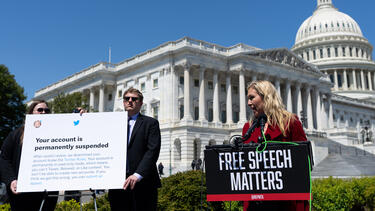We talked to Yale SOM’s Tauhid Zaman about his new research, which examined Twitter data from 2020 to see if conservative users were suspended for misinformation at a higher rate. His findings have implications for the current election season and beyond.

Representative Marjorie Taylor Greene holding a press conference on free speech and Twitter outside the Capitol in April 2022.Photo: Bill Clark/CQ-Roll Call, Inc via Getty Images
Tauhid Zaman
Associate Professor of Operations Management
October 15, 2024
Conservatives often say that social media platforms are biased against their point of view. What did your research into the 2020 election find about whether that was true?
Our research found that accounts sharing pro-Trump or conservative hashtags were suspended at a significantly higher rate than those sharing pro-Biden or liberal hashtags—they were about 4.4 times more likely to be suspended. At face value, this pattern could be interpreted as evidence of bias against conservatives. However, we also found that users associated with conservative-leaning content were more likely to share links from low-quality or misinformation-heavy sources, which the platform’s policies aimed to restrict.
Importantly, these results show that the increased suspension rate can be explained by Twitter’s politically neutral efforts to curb the spread of misinformation. The bias we observed wasn’t necessarily intentional or ideological on the part of the platform—it was a result of the differing media consumption patterns between political groups.
How do you determine what counts as misinformation in a politically polarized environment?
To address this challenge, we used a media quality score based on crowd-sourced ratings from politically balanced groups of people. These raters included equal representation from both sides of the political spectrum, which minimized the risk of partisan bias influencing the evaluations. The media quality score reflects how trustworthy different news domains are, as determined by this diverse crowd.
Looking for more insights?Sign up to get our top stories by email.
This approach ensured that even though there’s polarization in the U.S., the quality scores weren’t skewed toward one political perspective. It allowed us to assess low-quality content in a way that is fair and reflects consensus judgments rather than the views of any single political group.
What are the lessons in your research for social media platforms today?
There are two major lessons:Polarization and separate media universes. The research highlights how severe polarization has become in the U.S. People from different political backgrounds are consuming entirely different types of media—one side mainly engages with mainstream sources, while the other engages with more fringe or hyper-partisan sources. This fragmentation is not just a media problem; it reflects broader issues in our political discourse, where people operate in isolated information bubbles.Careful enforcement is critical during elections. Since the suspensions we observed primarily affected one side of the political spectrum during an election year, it is important for platforms to be extremely cautious with how they implement these policies. Even when enforcement is neutral in intent, it can appear biased and may erode public trust or impact election outcomes. Transparency and consistency in enforcement will be essential to ensure that anti-misinformation policies don’t unintentionally amplify perceptions of political bias, especially during politically sensitive periods.
Read a related study: “Differences in misinformation sharing can lead to politically asymmetric sanctions”
No comments:
Post a Comment